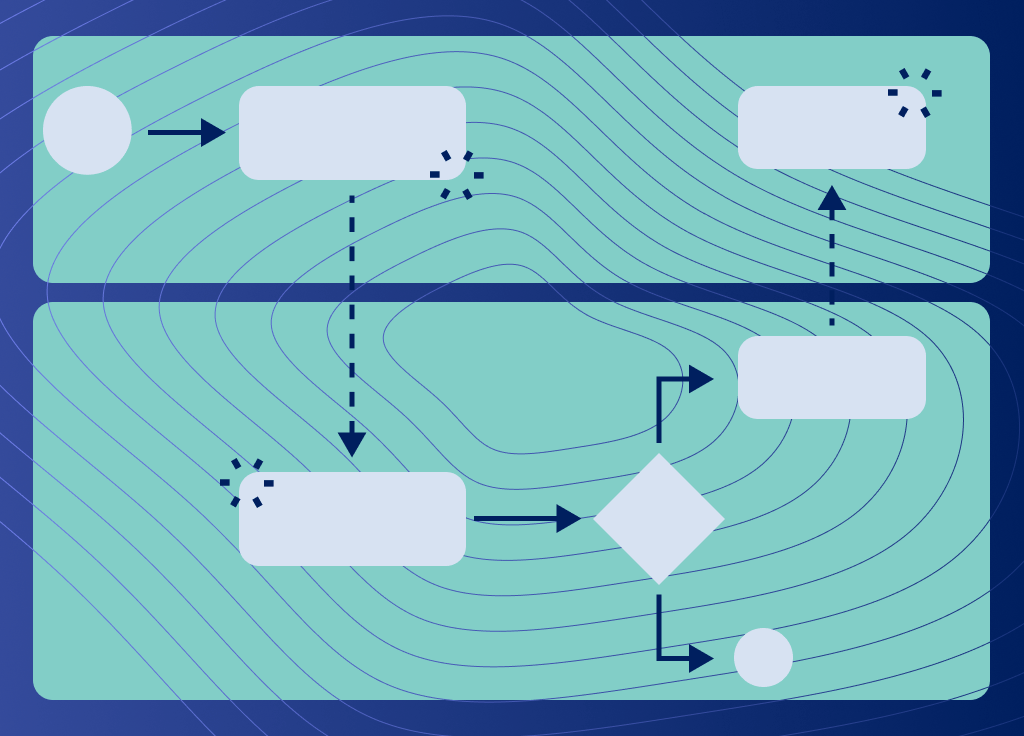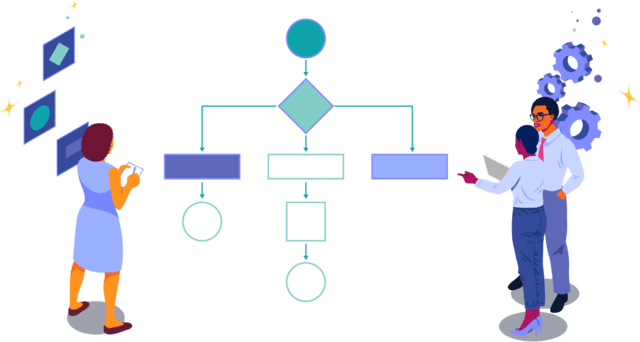What is business process modeling?

What is business process modeling?
Business process modeling lets organizations streamline operations, enhance productivity, and work steadily toward organizational goals. By identifying and analyzing workflows that need modeling; mapping out and redesigning processes; and then implementing and monitoring new business practice flows – organizations can increase both efficiency and consistency, at scale.

Why is business process modeling important?
Business process modeling helps organizations get more done, in the most effective ways possible. Whether you’re optimizing operations, building resilience against market changes, working toward scaling your business – or all of the above – the right processes make so much more possible for organizations.
Benefits of business process modeling
- Streamline processes. Eliminate Inefficiencies. Business process modeling helps map out bottlenecks and remove redundancies. Standardizing processes helps ensure consistent outcomes across organizations.
- Improve employee and customer outcomes. Make training easy with standardized onboarding and workflows. Offer customers more efficient and reliable processes to improve every experience.
- Create a path to continuous improvement. Data-driven insights make strategic decision-making more effective. Clearly outlined processes make adapting to changes simple.
- More transparency. Better communication. Clarify how processes function so it’s easier for employees to understand roles and responsibilities. Facilitate better communication among stakeholders.
Business process modeling is a key tool used within business process management, so it's important to understand its benefits to improve your organization’s processes.


How does business process modeling work?
By identifying, documenting, and analyzing processes, businesses enhance efficiency on a fundamental level. Mapping workflows, pinpointing inefficiencies, designing improvements, and implementing changes streamlines operations, improves communication, and promotes optimization.

Move work through your organization seamlessly to consistently exceed customer expectations.
Types of business process models
BPMN diagrams
Visually represent business processes using symbols for tasks, events, and gateways. Use these to simplify understanding, communication, and workflow analysis.
UML diagrams
This visual language for modeling software systems represents structures (classes, objects) and behaviors (use cases, activities) that aid in designing, understanding, and documenting workflows.
Flowcharts
Depict a process's steps and decisions using symbols and arrows. This simple, intuitive workflow visualization makes it easier to understand, analyze, and improve processes.
Gantt charts
These bar graphs are used to display project schedules: showing tasks, durations, and dependencies to create clear timelines for planning, tracking progress, and managing project timelines.
Elements of a business process model
Activities
Tasks or actions within a process that are fundamental to achieving process goals, such as "approve invoice" or "process order."
Events
Triggers or results within a process that mark the start, end, or changes in a process, like receiving an order (start) or completing a task (end).
Flows
Paths that connect logical elements in a workflow show the sequence and direction of activities and events that guide the order of operations.
Gateways
Decision points that control the flow of the process that manage how paths diverge or converge based on conditions, like yes/no decisions or parallel paths.
Swimlanes
Visual lanes that categorize activities by roles, departments, or systems to clarify responsibilities and enhance understanding of process ownership.
Data Objects
Information or documents used or produced by activities that show data flow and storage to ensure relevant information is available where needed.

Our intelligent service automation platform delivers optimized experiences at scale.
What are some use cases for business process modeling?
Optimize production lines
Mapping workflows lets manufacturers identify inefficiencies and bottlenecks – enabling smoother operations, better resource allocation, and reduced waste. Visualizing and analyzing each process step leads to improved productivity, quality, and responsiveness to supply chain or regulatory change.
Streamline patient intakes
By mapping and refining registration, triage, and documentation processes, healthcare companies can identify delays, improve staff communication, and ensure compliant procedures. The end result is enhanced efficiency, reduced wait times, and improved patient care.
Speed loan application processing
From application submission to approval – financial services companies can optimize verification processes and communication between departments. Quicker decisioning, reduced paperwork, and improved customer satisfaction improve outcomes all around.

What to look for in a business process modeling solution
The best business process modeling solutions prioritize ease of use, compatibility with existing systems, and robust collaboration features. Look for customization options, tools for analysis and simulation, scalability to handle complexity, strong security measures, reliable support and training, cost-effectiveness, and positive user feedback. Find the right solution that fits your organization's needs and creates best-ever process efficiency.
